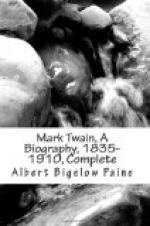Clemens could work at “The Lair,” often writing in shady seclusions along the shore, and he finished there the two-part serial,—[ Published in Harper’s Magazine for January and February, 1902.]—“The Double-Barrelled Detective Story,” intended originally as a burlesque on Sherlock Holmes. It did not altogether fulfil its purpose, and is hardly to be ranked as one of Mark Twain’s successes. It contains, however, one paragraph at least by which it is likely to be remembered, a hoax—his last one—on the reader. It runs as follows:
It was a crisp and spicy morning in early October. The lilacs and laburnums, lit with the glory-fires of autumn, hung burning and flashing in the upper air, a fairy bridge provided by kind nature for the wingless wild things that have their home in the tree-tops and would visit together; the larch and the pomegranate flung their purple and yellow flames in brilliant broad splashes along the slanting sweep of woodland, the sensuous fragrance of innumerable deciduous flowers rose upon the swooning atmosphere, far in the empty sky a solitary oesophagus slept upon motionless wing; everywhere brooded stillness, serenity, and the peace of God.
The warm light and luxury of this paragraph are factitious. The careful reader will, note that its various accessories are ridiculously associated, and only the most careless reader will accept the oesophagus as a bird. But it disturbed a great many admirers, and numerous letters of inquiry came wanting to know what it was all about. Some suspected the joke and taunted him with it; one such correspondent wrote:
My dear mark twain,—Reading your “Double-Barrelled Detective Story” in the January Harper’s late one night I came to the paragraph where you so beautifully describe “a crisp and spicy morning in early October.” I read along down the paragraph, conscious only of its woozy sound, until I brought up with a start against your oesophagus in the empty sky. Then I read the paragraph again. Oh, Mark Twain! Mark Twain! How could you do it? Put a trap like that into the midst of a tragical story? Do serenity and peace brood over you after you have done such a thing?
Who lit the lilacs, and which end up do they hang? When did larches begin to flame, and who set out the pomegranates in that canyon? What are deciduous flowers, and do they always “bloom in the fall, tra la”?
I have been making myself obnoxious to various people by demanding their opinion of that paragraph without telling them the name of the author. They say, “Very well done.” “The alliteration is so pretty.” “What’s an oesophagus, a bird?” “What’s it all mean, anyway?” I tell them it means Mark Twain, and that an oesophagus is a kind of swallow. Am I right? Or is it a gull? Or a gullet?
Hereafter if you must write such
things won’t you please be so kind
as to label them?
Very sincerely yours,
ALLETTA F. Dean.




